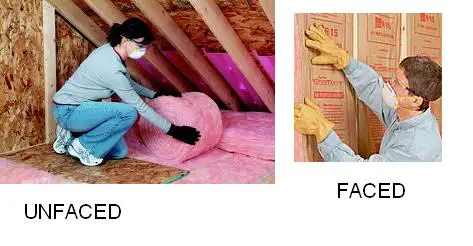When determining the right type of insulation for your space, it is best to look at faced insulation versus unfaced insulation. The only main difference between the two is the vapor barrier that faced insulation provides. Depending on your climate, faced insulation may be a requirement for meeting building codes. We will discuss here about both faced insulation and unfaced insulation with each of their pros, cons and installation process.
What is Faced Insulation
Faced Insulation is a blanket type insulation that is generally made of fiberglass. It has a vapor barrier that will block moisture from moving from one space into another. Most vapor barriers are made of Kraft paper. Faced insulation will be sold in batts or rolls that are then stapled to beams or joists. Roll out the batt and press in between the joists or studs and then staple to hold in place. Never fold over the insulation, cut with a utility knife.

Installing Faced Insulation
It is used in exterior walls, finished basements, floors, ceilings and attics. It is simply unrolled from the batts and stapled to the joists or studs. The insulation can also be used to fill cracks around windows and doors; however the facing needs to be peeled off if this is the case.
Cold climates need to have the insulation with the vapor barrier facing outside the house. Warmer climates need the insulation with the vapor barrier facing inside the house.
Advantages of Faced Insulation
Some advantages of faced insulation includes the following:
- A moisture barrier is created.
- Installation is easier.
Disadvantages of Face Insulation
The disadvantages includes:
- It is combustible and should not come in close contact with heating sources of any kind including light fixtures and electrical devices.
- It is not a good solution for adding insulation over existing insulation.
What is Unfaced Insulation
Unfaced insulation is blanket type insulation and is also generally made of fiberglass. It does not have a vapor barrier that will block moisture between spaces. It, too, is sold in batts or rolls. It is not stables but is held in place by friction.
There are times when unfaced insulation will be used with plastic sheeting to create a makeshift vapor barrier. Colder climates will generally require unfaced insulation rather than faced insulation. The lack of vapor barrier does not have an effect on the R-value of the insulation.
Installing Unfaced Insulation
Unroll the batt and lay the unfaced insulation between the joists or studs. Be careful not the compress the insulation. If it is compressed too much, the efficiency is reduced. The batts are fastened loosely to the joists with plastic straps to keep it from shifting. Never fold the batts over, cut with a utility knife.
Advantages of Unfaced Insulation
Benefits of unfaced insulation are as follows.
- It is great for adding to existing insulation.
- It is noncombustible and is safer to use in close proximity to heat sources.
Disadvantages of Unfaced Insulation
There are some disadvantages of unfaced insulation.
- It does not have a moisture barrier.
- It is more difficult to install and takes longer.
